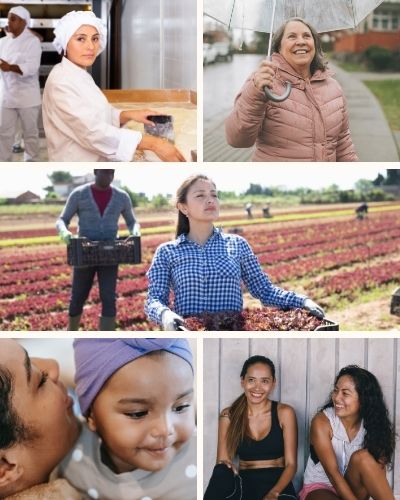
On March 8, we celebrated International Women's Day—a holiday that originated within the labor movement as women protested for better pay, safer working conditions, and the right to vote. Over a century later, we cheered as a historic fight for equal pay transcended women's sports; together elected the first woman Vice President of the United States; and benefitted from the strong, swift response of women leaders worldwide to an unknown and quickly worsening public health crisis.
As another Women's History Month ends, I am grateful to celebrate tremendous progress—globally, across the United States, and here in New Jersey. But, this March in particular, I am reminded that poverty is also a women’s rights issue, and that anti-poverty work is one of the most powerful ways to advance gender equality. We must address the persistence of gender-based violence and discrimination, and continue efforts to uplift and empower not only the women in New Jersey, but also the 22 million women experiencing poverty nationally—in the richest country in the world.1 Across the U.S., women experience higher rates of poverty than men, with American Indian or Alaska Native (AIAN), Black, and Latina women experiencing the highest rates of poverty. Here in New Jersey, 10% of women live under the federal poverty level, a measure widely considered to be outdated and inaccurate. Based on a more accurate standard of 300% FPL, a staggering 35% of women lived in what we consider true poverty in 2019.2
Suffering the brunt of pandemic-related job losses, millions of American women have lost jobs in the past year.3 As schools closed and family members fell ill, women tackled additional family care responsibilities. Many were forced out of the workforce due to exorbitant childcare costs and the lack of critical work-family policies and benefits, from paid sick, family, and medical leave to childcare assistance for low- and moderate-income folks4. Even as women attempt to shelter safely at home, they face both increased rates of gender-based violence and abuse and steeper barriers to safely access help.5
The pandemic has halted women's steady progress in the workforce; aggravated both the gender and racial wage and wealth gaps; and thrown into sharp relief the heightened risk of poverty to women of color. American women’s participation in the workforce has now dropped to its lowest level since 1988, with Black and Latina women experiencing the highest levels of unemployment.6
Legal Services of New Jersey’s work of civil legal assistance touches upon many areas of particular concern and consequence to women, including domestic violence, sexual assault, and trafficking and abuse. But all areas of civil legal aid affect women disparately, and often disproportionally, via the intersections of gender; race; ethnicity; ability; marital and citizenship status; sexual orientation; age; and more:
- Women make less money on average than men, with Black women making $0.58, Latina women making $0.47, and white women making $0.82 to every $1.00 a white man in New Jersey makes.7
-
Because women more often work in lower paying or part-time jobs and leave the workforce at higher rates to care for children and elderly family members, they are, according to a Department of Labor study, “appreciably” less likely to receive unemployment benefits compared to men—of particular cost and consequence during the coronavirus pandemic.8
-
Access to affordable, quality healthcare has particular implications for women, who are more likely to use health care for reproductive health and maternity issues.9
-
Women are more likely to face eviction from rental housing than men and are also at higher risk for mortgage foreclosure.10
As our state and country come together to overcome the pandemic and its far-reaching, often disproportionate effects, LSNJ will continue to oppose injustice in all its forms—including sexism, structural racism, and all their intersections. While there is much work to do, I thank you for joining us as we recommit to the work and policies that will ensure equal justice and economic security and opportunity for all.
With gratitude to Emily Kraeck, special assistant at LSNJ, for her considerable contribution to this piece.
1 Source: U.S. Census Bureau, 2019 American Community Survey; Bleiweis, Robin, et al. Center for American Progress, 2020, The Basic Facts About Women in Poverty.
2 LSNJ Poverty Research Institute. Source: U.S. Census Bureau, 2019 American Community Survey, One–Year estimates.
3 Ewing-Nelson, Claire. National Women's Law Center, 2021, Another 275,000 Women Left the Labor Force in January. Since February 2020, women have lost over 5.3 million net jobs and account for 53.8% of overall net job loss since the start of the pandemic.
4 Ibid. Latina women represent 18.1 percent of all women in the U.S. population, but constitute 27.1 percent of women in poverty. Black women represent 22.3 percent of women in poverty but 12.8 percent of all women in the U.S. population.
5 Kluger, Jeffrey. “Domestic Violence Is a Pandemic Within the COVID-19 Pandemic.” Time, 3 Feb. 2021, time.com/5928539/domestic-violence-covid-19/.
6 Ewing-Nelson, National Women’s Law Center. More than 1 in 12 Black women ages 20 and over (8.5%) were unemployed in January 2021, more than 1.7 times higher than their pre-pandemic unemployment rate (4.9% in February 2020). Nearly 1 in 11 Latinas ages 20 and over (8.8%) were unemployed in January, nearly 1.8 times their pre-pandemic unemployment rate (4.9% in February 2020).
7 Source: Poverty Research institute using U.S. Census Bureau, 2019 American Community Survey (PUMS Data)
8 Carr, Catherine, "Moving Women out of Poverty: A Call to Action for Legal Aid" (2016). Impact Center for Public Interest Law. Book 11.
9 Ibid.
10 Ibid.
|